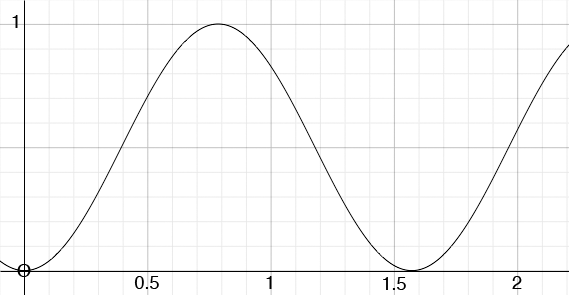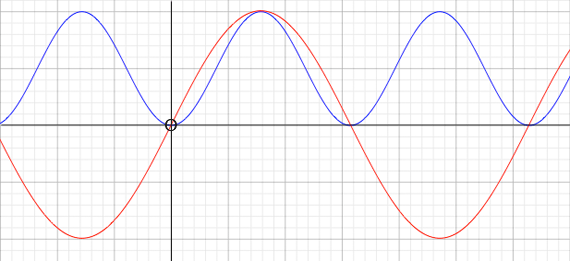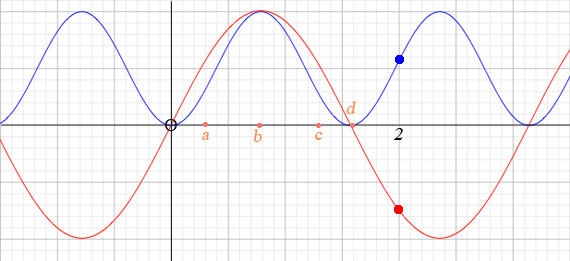| |||
| Math Central | Quandaries & Queries |
|
Question from Claudette, a parent: The problem is stated thusly: If the position function of a particle is x(t) = sin^2(2t), find the distance that the particle travels from t = 0 to t = 2 I am having a heck of a time trying to make sense of this question. I know the answer. It is 2 + sin^2(4). However this doesn't compute in my mind. I've attempted to interpret the 4 as four radians, but that doesn't make any sense to me in terms of distance. Computed the answer according to the author is 2.57. 2.57 what? I am a parent trying to help my daughter study for the AP in calculus. It appears in the distance, velocity and acceleration section. I have no problem with, for example, a problem that requests velocity, and acceleration having been given a distance formula. Example, if X(t) is t^3 + t^2 + 90, the velocity would be 3t^2 + 2t, and the acceleration 6t + 2. That being said, asking for the distance using sin^2 (2t) with t being 2 is a nonstarter for me. I would very much appreciate your insight here |
Hi Claudette,
This is a particle moving along a line and its distance from the origin is given by x(t) = sin2(2t) for t between 0 and 2. It would be nice if units were given but they are not so I will say distance units. I drew a graph of x(t) = sin2(2t)

x(t) = sin2(2t)
The height of this function tells you the distance the particle is from the origin, so for example when t = 0.5 the particle is approximately 0.7 distance units from the origin.
The particle starts at a distance of 0 units from the origin at t = 0 and moves away from the origin attaining a distance of 1 unit at t approximately 0.8. It then moves back toward the origin and reaches the origin when t is a little larges than 1.5. Thus as t moves from 0 to 1.5 the particle moves 1 unit from the origin and then returns to the origin, thus traveling 1 + 1 = 2 distance units.
Looking at the graph above you can see that the point again moves away from the origin until t = 2. When t = 2, x(t) = x(2) = sin2(4). Thus in total the point have moved 2 + sin2(4) distance units.
I hope this helps,
Harley
Claudette responded
In his answer, Harley has drawn a graph that shows sin2(2t) in action. However, helpful as that is, the author of the problem has stated that the distance is 2.57. Obviously it is helpful to see the graph, but this problem calls for a specific decimal measurement.
Is it possible, given the information by this author, to actually compute 2.57 in a mathematical sense WITHOUT a graph being drawn. I suppose also, it is a bit confusing when I see sin2(2t). What is the difference in a graph between sin2(2t) and sin(2t)?
Another question for clarification sake.
At the conclusion to the problem, the answer is expressed by the author as 2 + sin2(4) Why is the notation sin2(4) an ADDITION to the 2. I am assuming that the Sin2(4) somehow is equivalent to .57, since the author of the problem states that the answer is 2.57. How do we determine that sin2(4) is equal to .57, since the final answer is 2 + sin2(4)?
Warm Regards,
Claudette
Hi again Claudette,
The notation sin2(2t) means (sin(2t))2. Something that is important to see in this problem is that the variable 2t is measured in radians not degrees. I used my calculator to find sin(4) and got sin(4) = -0.7568. (If you do this make sure your calculator is set to radians.) Thus
sin2(4) = (sin(4))2 = (-0.7568)2 = 0.57
Thus the answer in decimal form is
2 + sin2(4) = 2 + 0.57 = 2.57
I plotted sin(2x) and sin2(2x) on the same graph o that you can see how they compare

sin(2x) and sin2(2x)
You certainly can solve this problem without a graph of the function but you need a general idea of its shape. The arch in the sin2(2t) function to the right of the origin says that the particle moves away from the origin a distance of 1 distance unit and then returns to the origin going a total of 2 distance units. It then moves away from the origin a distance of sin2(4) = 0.57 distance units.
I hope this helps,
Harley
Dear Harley:
Thanks again!
My problem is that if we look at the graph, the frequency seems to be the same for sin^2 (2A) and sin (2a) If that is true, I don't see how the distance traveled by the particle can be different in the same amount of time.
Stated differently, the graph confuses the issue for me.
The extreme of both values is still "1" and the time is the same. If the frequencies are the same as well, I don't really have a clue in terms of doing the problem mathematically.
How we can translate sin2(4) as .57 is simply a mystery. Stated differently, how can sin2(4) be .57? What is the formula for that? How do we show mathematically (not using the graph at all) that sin2(4) equals .57.
And further WITHOUT benefit of the graph, how can we say that the answer here is 2 + sin2(4)?
All I am really seeing is the particle reaching is maximum and minimum on the graph a couple of times, and then at the end having a bit left over which is labeled as .57.
If my life depended on it, I wouldn't be able without the graph to even come close to telling
anyone why sin2(4) would have such a value.
For example, when we calculate a derivative for an equation such as x5 + x4 + x3 we have a process that is clear. The derivative would be x4 + x3, etc When calculating a distance on a straight line we can use the distance formula. Here, all I am seeing is a graph with nothing to support it with a formula or process. We are just being told that the answer is 2+ Sin2(4), check it out on the graph.
What am I missing, Harley? You seem so confident. I am sure you are seeing a lot more than I am here.
Had I a graphics calculator, I would not have a problem doing the graph, but leaving that out of the picture (no pun) how can I do this with pencil and paper.
What is the formulaic process, Harley?
I am feeling very slow indeed!
Warm Regards,
Claudette
Claudette,
"How do we show mathematically (not using the graph at all)" Mathematicians have been doing geometry and using diagrams for thousands of years. To somehow suggest that using the graph is not mathematics is ignoring thousands of years of history. Trying to do mathematics whiling ignoring geometry is like learning to play the piano but insisting on only using your left hand. Mathematics is so much more than using formulas.
There is a great deal of information in the graph.

At time zero I am in my red car at a stop light and beside me is a red car. We are both facing east. When the light turns green the red car starts away much more quickly than I do. At the time labeled a on the diagram The red car is further from the light than I am. One unit distance from the light, at point b, we both do a u-turn. I navigate the u-turn better than the red car and when we come out of the turn I am closer to the stop light than the red car at point c. I have to slow down at the light and make another u-turn while the red car continues west. At the time when t = 2 our positions are shown by the dots on the graphs. This is more information than you need to solve the problem but you said "I don't see how the distance traveled by the particle can be different in the same amount of time."
How do you solve the problem without a graphing calculator? You need to recognize that sin2(2t) is zero at t = 0, 1 at 2t = π/2 and the zero again at 2t = π or t = π/2 which is approximately t = 3/2 = 1.5. Thus in approximately 1.5 time units the particle has gone from 0 to 1 and back to zero for a total of 2 distance units. sin2(2t) is again 1 at 2t = 3π/2 or t = 3π/4 which is larger than 2 so t = 2 before the particle is again 1 distance unit from the origin. In fact at time t = 2 the distance from the origin is sin2(2 × 2) = sin2(4).
This is the one place where I need to use a calculator. I make sure my calculator is in radian measure and evaluate sin(4). I obtain sin(4) = -0.7568. But I want sin2(4) = (sin(4))2 = (-0.7568)2 = 0.57 distance units. Thus in the time from t = 0 to t = 2 the particle has gone 2 + 0.57 = 2.57 distance units.
Harley
 |
||
Math Central is supported by the University of Regina and The Pacific Institute for the Mathematical Sciences.